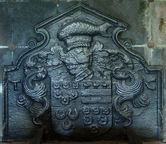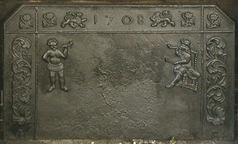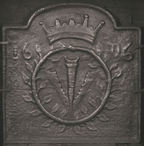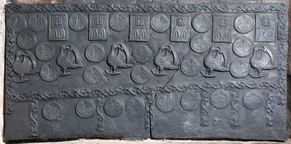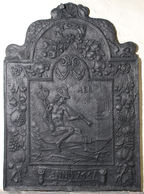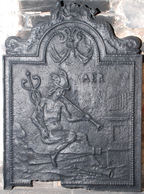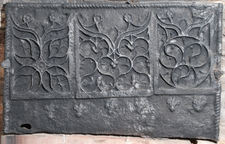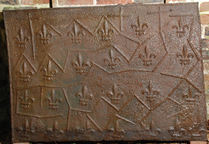-
857
Description: Rectangular with detached pediment linked by S-curves, protruding from each of which is a small scroll; cavetto-moulded edging (top and sides); quartered shield with helm, crest and mantling; initials in top corners.
Notes: The arms are of Sir Julius Caesar (1558-1636), judge and politician, Chancellor of the Exchequer 1606-13. Blazon: Quarterly, 1st and 4th, Gules, three roses argent, on a chief of the second three roses of the first (Caesar); 2nd, argent, two bars sable, on a chief of the second three swans of the first (?Martin); 3rd, gules, three crescents argent (Peryent/Perin). Crest: a dolphin embowed in the sea vert. This example has the additional initials, TC. The style of the carving is the same as on two other firebacks in the same county.
Copies of this fireback are known.
Inscription: T C
Arms: Caesar
- Decoration tags:
- rectangular with detached pediment (shape)
- cavetto (edging)
- whole carved pattern
- individual letters
- planklines
- armorial
- text
Manufactured: in the early-17th century possibly in the Herefordshire area of England.
Current location: Croft Castle, Yarpole, Herefordshire, England.
Museum number: 537532 (part of the National Trust museum group)
- Attached to series:
- Personal armorial firebacks
- Loop edged firebacks
- Herefordshire armorial series
-
55
Description: Canted rectangle; cavetto moulded edging (top and sides); single horizontal fillet below canted corners and vertical fillet parallel to each side, dividing the fireback into two side panels, two top corner panels, top panel and main central panel; ‘daisy’ plant stamp in top corners, and at outer end of top panel enclosing two, opposite facing, lion passant stamps with date between; swirling foliage stamp repeated in each side panel above initial, I to left, B to right; stamp of ‘Indian’ smoking a pipe in top left of central panel, stamp of seated ‘gentleman’ smoking a pipe and holding another, at top right.
Notes: The 'daisy' stamp and the IB initials are identical to those on similar firebacks dated between 1703 and 1721, and probably indicating the same founder. The use of stamps relating to tobacco smoking may suggest an origin near Bristol, the main entry port for the tobacco trade at that time. Lent to Dyrham Park by the late John Workman OBE, of Sheepscombe, Gloucs. in 1963, and given in 1996.
Inscription: 1708 / I B
- Decoration tags:
- rectangular with canted top corners (shape)
- cavetto (edging)
- carved stamps
- individual numbers
- heraldic
- text
- animals
- humans
- plants
Manufactured: in 1708 in the Forest of Dean area of England.
Current location: Dyrham Park, Dyrham, Gloucestershire, England.
Museum number: 453259 (part of the National Trust museum group)
- Attached to series:
- IB series
- Date & initials firebacks
-
56
Description: Flattened arched rectangular shape; cavetto moulded edge all round; Stuart royal arms with lion and unicorn supporters, crown, garter and motto; CR initials placed separately outside supporters; date split either side of crown.
Notes: A much-copied variant with the additional initials, I T, above the date and on either side of the crown.
Copies of this fireback are known.
Inscription: I T / 1635 / C R / HONI SOIT QVI MAL Y PENSE / DIEV ET MON DROIT
Arms: English Stuart royal (Charles I )
- Decoration tags:
- rectangular with round arch (shape)
- cavetto (edging)
- whole carved pattern
- planklines
- armorial
- royal
- text
Manufactured: in 1635 in the Weald area of England.
Current location: Dyrham Park, Dyrham, Gloucestershire, England.
Museum number: 453291 (part of the National Trust museum group)
Citation: Lloyd, N., 1925, 'Domestic Ironwork I', Architectural Review, 58, pp. 58-67.
- Attached to series:
- Carolean royal armorial firebacks
- Stuart royal armorial firebacks
-
58
Description: Arched rectangular shape; cavetto edging; a pheon (a downward-pointing arrow head barbed on the inner edge), the badge of the Sidneys, within a wreath, an earl’s coronet above; the date on either side of the coronet.
Notes: The badge is of the Sidneys, Earls of Leicester. The date is most likely to be 1626 as the Earldom was not conferred upon Robert Sidney until 1618 and he died in 1626. A recast plate.
Inscription: 16 [?]26
Arms: Badge of Sidney family, Earls of Leicester
- Decoration tags:
- rectangular with round arch (shape)
- astragal (edging)
- whole carved pattern
- individual numbers
- heraldic
- text
Manufactured: in the early- to mid-17th century possibly at Robertsbridge Furnace, Salehurst in the Weald area of England.
Current location: Florence Court, Enniskillen, Fermanagh, Northern Ireland.
Museum number: 630836 (part of the National Trust museum group)
- Attached to series:
- Earl of Leicester series
- Personal firebacks
-
96
Description: Rectangular; undulating vine tendril edging (top and upper sides); eight circular, fleur-de-lys butter mould stamps alternating (except at left end) with six rectangular, fleur-de-lys and leaf shortbread or gingerbread stamps, in a line along the top; six bird stamps (wings displayed and inverted) alternating with five pairs of butter mould stamps, as above; continuous line of horizontal vine strips; six descending vine strips, interspaced unevenly with eight butter mould stamps, in pairs except for rightmost two.
Notes: The bird (probably a swan, a Lancastrian badge) and vine strip stamps are encountered on several firebacks. In 1868 this fireback was recorded at Tickeridge, West Hoathly, Sussex.
- Decoration tags:
- rectangular (shape)
- trailing vine (edging)
- simple stamps
- carved stamps
- animals
- plants
- objects
Manufactured: in the mid- to late-16th century possibly at Pounsley Furnace, Framfield in the Weald area of England.
Current location: Nymans, Staplefield Road, Handcross, Slaugham, West Sussex, England.
Museum number: 1206011 (part of the National Trust museum group)
Citation: Stenning, J. C., 1868, 'Notes on East-Grinstead', Sussex Archaeological Collections, 20, pp. 151-2.
-
97
Description: Arched rectangular shaped central panel with bead edging; naked figure of Mercury/Hermes with winged helmet (petasos), holding a snake-entwined staff (caduceus); he is sitting astride a pair of bellows and blowing a straight trumpet; a twice-bent trumpet lies at his feet; the bellows are pumping air into an organ; to the right of his head is the word, AER (air - Latin); above is a swag of drapery; arched rectangular shaped border with ovolo edging; floral wreath at top with suspended swags of fruit and leaves, including, grapes, pomegranates and apples; inscription, ‘ANNO 1661’, on a scroll at the bottom; scallop shell and sea serpents on top.
Notes: One of a series of firebacks symbolising the four elements.
Copies of this fireback are known.
Inscription: AER / ANNO 1667
- Decoration tags:
- 'Dutch' (shape)
- ovolo (edging)
- whole carved pattern
- mythological
- allegorical
- text
- humans
- objects
Manufactured: in 1667 possibly in the Siegerland area of Germany.
Current location: Nymans, Staplefield Road, Handcross, Slaugham, West Sussex, England.
Museum number: 1206008 (part of the National Trust museum group)
- Attached to series:
- 'Dutch' Miscellaneous Firebacks
- Elements firebacks
-
98
Description: Arched rectangular shaped central panel with bead edging; naked figure of Mercury/Hermes with winged helmet (petasos), holding a snake-entwined staff (caduceus); he is sitting astride a pair of bellows and blowing a straight trumpet; a twice-bent trumpet lies at his feet; the bellows are pumping air into an organ; to the right of his head is the word, AER (air - Latin); above is a swag of drapery; outside the panel is a narrow border of the same shape with fillet edging; the fireback is surmounted by a scallop shell between two outward-facing sea serpents.
Notes: One of a series of firebacks symbolising the four elements.
Copies of this fireback are known.
Inscription: AER
- Decoration tags:
- 'Dutch' (shape)
- fillet (edging)
- whole carved pattern
- mythological
- allegorical
- text
- humans
- objects
Manufactured: in the mid- to late-17th century in England.
Current location: Nymans, Staplefield Road, Handcross, Slaugham, West Sussex, England.
Museum number: 1206021 (part of the National Trust museum group)
- Attached to series:
- 'Dutch' Miscellaneous Firebacks
- Elements firebacks
-
99
Description: Quasi-rectangular; twisted rope edging (top and sides); three gothic panels arranged horizontally, the centre one wider than the other two, each panel a symmetrical arrangement of tracery patterns with an inverted ogee arch on top incorporating two flowers; below are six, irregularly spaced fleurs-de-lys.
Notes: The panels were probably derived from a dismantled wooden chest or hutch table, c.1500. Their gothic style belies the probable age of the fireback, such chests already being old when their parts might have been re-used. The same panels are on a fireback at East Grinstead Museum.
- Decoration tags:
- rectangular (shape)
- rope (edging)
- carved pattern panels
- architectural
Manufactured: in the early- to mid-16th century in the Weald area of England.
Current location: Nymans, Staplefield Road, Handcross, Slaugham, West Sussex, England.
Museum number: 1206065 (part of the National Trust museum group)
- Attached to series:
- Gothic panel series
- Furniture stamp firebacks
-
311
Description: Quasi-rectangular; twisted rope edging (top and sides); fleur-de-lys stamp repeated 25 times in four rows (6-6-6-7), interspersed with a length of twisted rope repeatedly stamped between each row and sometimes between fleurs; three rope crosses near top corners.
Notes: The fleurs are identical to others from the ‘Pounsley’ series.
- Decoration tags:
- rectangular (shape)
- rope (edging)
- simple stamps
- carved stamps
- heraldic
- objects
Manufactured: in the mid- to late-16th century possibly at Pounsley Furnace, Framfield in the Weald area of England.
Current location: Nymans, Staplefield Road, Handcross, Slaugham, West Sussex, England.
(part of the National Trust museum group)
- Attached to series:
- Pounsley series
-
313
Description: Arched rectangular shape; cavetto moulded edging; date top centre within arch.
Notes: Plain elegant fireback from a late series, probably cast in the south east of England. The crack emanating from the top right corner of the fireback seems to be a weakness on all the recorded examples, and may have caused by thinness of the base board at that point.
Inscription: 1853
- Decoration tags:
- rectangular with round arch (shape)
- cavetto (edging)
- carved stamps
- individual numbers
- text
Manufactured: in 1853 in England.
Current location: Nymans, Staplefield Road, Handcross, Slaugham, West Sussex, England.
(part of the National Trust museum group)
- Attached to series:
- 1850s series
- Date only firebacks
